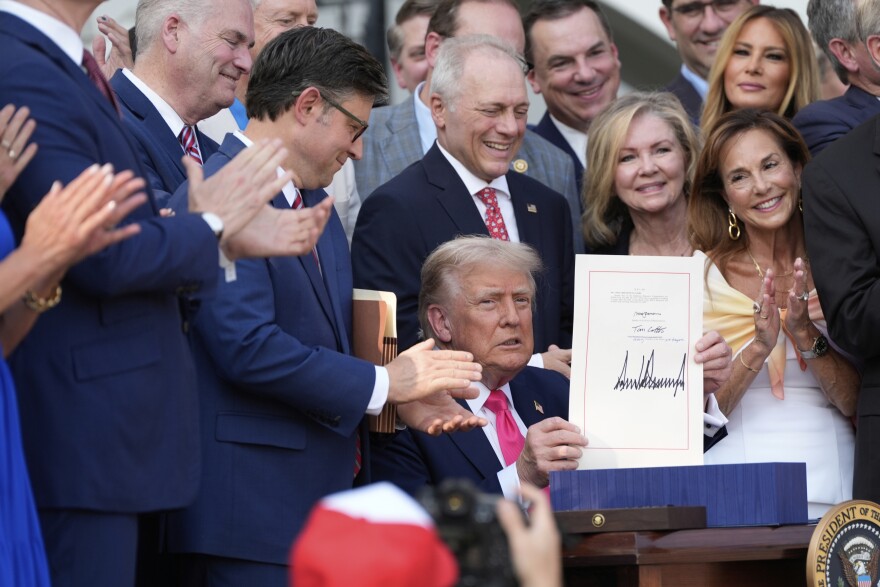After just six months in office, President Donald Trump, with a helping hand from Congress, has sought to reshape federal education policy.
At the Utah Board of Higher Education’s July meeting, leaders from the state’s higher ed system broke down some of the implications for schools and students in Utah.
Research Funding
The federal government canceled 77 research grants at the University of Utah, according to Vice President of Research Erin Rothwell. That translates to about $28.4 million in lost current and future funding.
But to Rothwell, the most alarming cut is still up in the air. The Trump administration wants to limit how much colleges can receive in federal grants for the “indirect costs” of research, often called the “facilities and administrative rate,” which can go toward things like utilities and research lab maintenance.
The amount is typically negotiated at the individual institution level, and the U’s rate is currently set at 54% for on-campus research. That means for every federal grant dollar the university receives for research, it can get an additional $0.54 to help cover infrastructure and operational costs.
Over the past few months, several federal agencies have tried to cap that indirect costs rate at 15%.
Rothwell said that would result in the university losing $110 million annually.
So far, all of the proposed policies that would have enforced that cap have been blocked, at least temporarily, by courts.
But if it were to be enforced in the future, Rothwell told the state’s higher education board July 18, “We would not be able to conduct research as we have today, and we would significantly lower the amount of research we could conduct.”
Rothwell is working with a coalition of national organizations representing academic, medical and research institutions — called the Joint Association Group — to try to come up with a compromise. They propose a new research funding model, which would be a softer financial blow to the university.
The administration has also proposed shrinking funding to the National Institutes of Health by nearly 40%. About 40% of the university's research funding comes from that agency, totalling $295 million this year.
Compared to other institutions, like Harvard University, Rothwell said the university is relatively weathering things. Still, she said there’s a long road ahead.
Federal loan caps
For graduate students, there will soon be new limits on how much they can borrow in federal student loans.
Under the Grad Plus Program, which will be shuttered in July 2026, students could borrow up to the cost of attendance. The “One Big Beautiful Bill” sets new limits.
Soon, graduate students will only be able to borrow up to $20,500 a year. The total loan limit will be $100,000. For students in professional graduate degree programs, like medical or law school, their cap will be $50,000 a year with an aggregate limit cap of $200,000. There will also be a lifetime cap of $257,000 for all types of federal student loans.
Utah State University Interim President Alan Smith worries specifically about non-resident students in their veterinary medicine program. Smith told the board vet school is four years and tuition runs about $52,000 a year. He said there are not a lot of these veterinary medicine schools in the country.
“It does move those students toward private loans, which obviously often come with higher interest rates,” Smith said.
At the U, the president’s chief of staff Troy D’Ambrosio told the board they’re anticipating impacts across all of their graduate programs.
“It's going to have a significant hit on us. We haven't fully assessed the impact of what it'll look like,” D’Ambrosio said.
Nationwide, experts have theorized about the impacts. Some believe funding cuts will cause schools to lower tuition. But others worry some students will now have to either take out private loans or be unable to pursue those programs altogether.
Utah’s Commissioner of Higher Education Geoffrey Landward thinks there will be a push for states to fill in the gap by providing their own financial aid opportunities and loan programs.
“Just another policy issue to anticipate that we may have to address at some point,” he told the board.
Tighter state budgets
While not directly related to higher education, there could be some trickle-down effects from the SNAP and Medicaid cuts. Landward said several changes to those two programs will result in new administrative expectations and costs for states starting in 2028.
New demands could leave less funding available for higher education in the state’s budget, Landward said.
Focus on workforce
Like Utah’s GOP, the Trump administration and Republicans in Congress want higher education to be more tied to the workforce and for institutions to be held responsible for their return on investment.
The tax and spending bill expands Pell Grants, which help low-income students pay for college, to include short-term job-training programs starting in the 2026-2027 school year. According to Utah higher education leaders, that means 30 technical education programs in the state will be newly eligible, including firefighting and emergency medical technician.
Katie Mazzie, the Utah System of Higher Education’s associate commissioner of strategic initiatives, community & government relations, said it's an exciting development, but the process for getting those programs approved “is a little murky right now.”
A new “earnings test” will also require undergrad programs to show most of their graduates earn more than the state’s median high school grad. If a program fails to meet that standard two times in three years, it could lose federal funding.
Future outlook
Landward said from talking with Education Secretary Linda McMahon, it's clear the Trump administration intends to dismantle the Department of Education. With that in mind, Landward said he’s talking with other states about developing proposals to preserve and take over programs currently run at the federal level.
With the rapid changes, Utah’s board asked for another federal policy update at its next meeting.
Editor’s note: KUER is a licensee of the University of Utah but operates as an editorially independent news organization.






